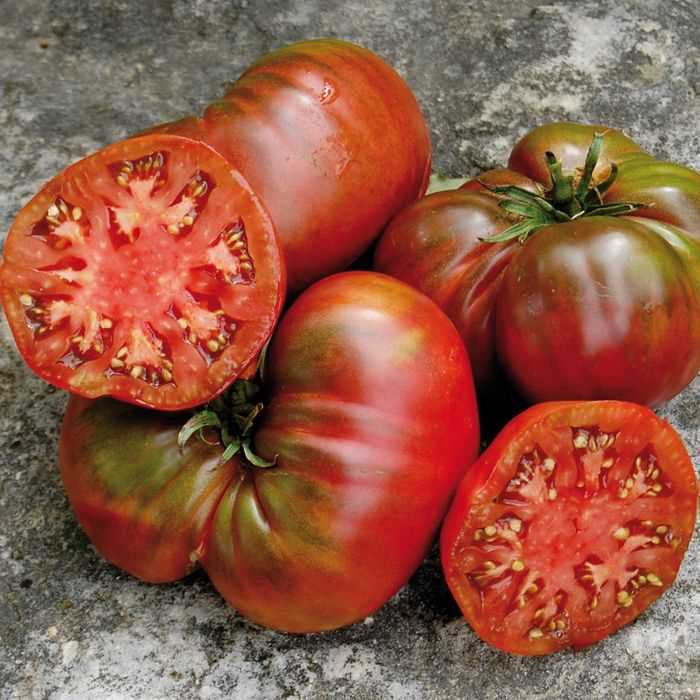Growing up in a humid climate, I was familiar with the classic ‘Better Boy’ tomato: big, red, and carried on plants with lobed leaves. However, when I first encountered a variety with broad, potato-like foliage, I mistakenly thought I had planted eggplants instead of ‘Prudens Purple’. Over the years, I’ve cultivated other potato-leaf varieties like ‘Stupice’ and ‘German Pink’ and discovered that these tomatoes often offer exceptional flavor. Here’s what I learned about their unique characteristics.
Potato Leaf vs. Regular Tomato Leaves
Most tomatoes feature wild or regular leaves, which are composed of seven leaflets attached to a central stem. This is the dominant leaf shape for Solanum lycopersicum, the species most tomatoes belong to. Potato leaf varieties are a result of genetic mutations, where the leaves fuse into larger, broader shapes. Although the precise origin of this mutation is unknown, it is believed to have occurred in Europe, where many potato-leaf varieties, such as those from Russia, the Czech Republic, Germany, and Poland, were developed.

By the early 1900s, potato leaf varieties had become popular among European and North American gardeners. Today, varieties of all maturations, from fast-maturing types to late-bearers, are available, making them suitable for a range of climates.
Why Are Potato Leaf Tomatoes Sweeter?
Potato leaf tomatoes are renowned for their rich, sweet flavor, but is this just a belief or a real characteristic? A 2019 study by the University of California studied 18 potato-leaf varieties and found that they contained higher levels of soluble sugars compared to regular-leaf tomatoes. Varieties like ‘Bloody Butcher’, ‘Glacier’, ‘Stupice’, ‘Brandywine’, and ‘Pruden’s Purple’ were especially high in sugar content.
This sweetness is due to the genetic mutation that produces the potato-leaf shape. The mutation affects the plant’s resource distribution, directing more energy toward fruit production rather than foliage growth. This altered physiology contributes to the sweeter, more flavorful tomatoes of potato-leaf varieties.
Popular Potato Leaf Tomato Varieties
Contrary to the misconception that potato-leaf tomatoes need warm climates, many early-maturing, cold-tolerant varieties were developed in northern Europe’s short summer climates. Varieties like ‘Siberia’, ‘Black Sea Man’, and ‘Japanese Black Trifele’ came from Russia, while ‘Stupice’ was bred in the Czech Republic, and ‘Glacier’ is a Swedish heirloom. These early varieties mature in under 70 days, making them perfect for cooler climates. They generally produce small, red, cluster tomatoes, with ‘Stupice’ being a favorite for eating raw.

For those in warmer regions, large beefsteak varieties like ‘Brandywine’ and ‘German Pink’ offer rich flavor and large fruit. ‘Green Giant’ is also a popular choice, as its fruits are less prone to damage from birds and squirrels.
Tomato breeders continue to experiment with new potato-leaf varieties, often crossing them with regular-leaf types, so you can find a wide range of unique flavors and sizes.
Early Maturing Potato Leaf Varieties (55-65 Days from Transplanting)
These varieties usually bear small red tomatoes in clusters and can be grown in containers. Some are determinate (producing a single large crop) while others are indeterminate (producing fruit over a longer period). Popular choices include:
- Bloody Butcher (indeterminate)
- Glacier (determinate)
- Matina (indeterminate)
- Siberia (determinate)
- Stupice (indeterminate)
Mid-Season Potato Leaf Varieties (75 Days from Transplanting)
These varieties produce larger clusters and more complex fruit shapes and colors. Many are mahogany red with green shoulders. Consider:
- Black Sea Man (determinate)
- Burwood’s Prize (indeterminate)
- Japanese Black Trifele (indeterminate)
- Pruden’s Purple (indeterminate)
Late-Season Potato Leaf Varieties (80+ Days from Transplanting)
These full-season varieties yield large, beefsteak-type tomatoes, making them a delight for tomato enthusiasts. Some favorites include:
- Brandywine (indeterminate)
- German Pink (indeterminate)
- Green Giant (indeterminate)
- Lillian’s Yellow (indeterminate)
- Mariana’s Peace (indeterminate)
- Soldaki (indeterminate)
- Valena Pink (indeterminate)
Whether you’re growing in a cool or warm climate, the diverse range of potato-leaf varieties offers exceptional flavor and a wide array of textures and colors. With their superior taste and unique growing characteristics, these tomatoes are a must-try for any garden enthusiast.
